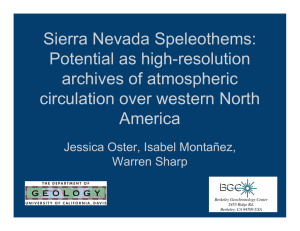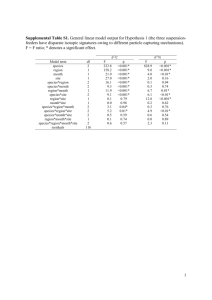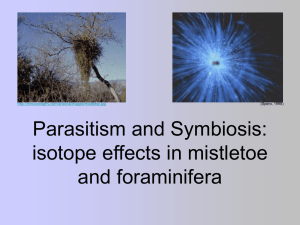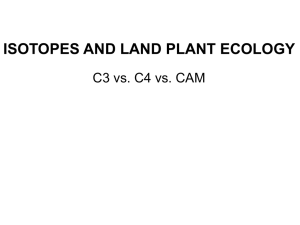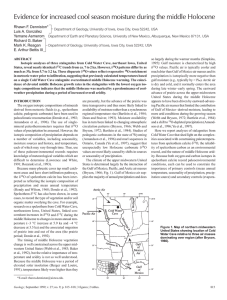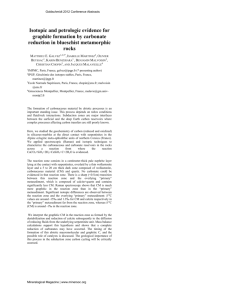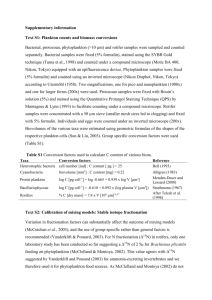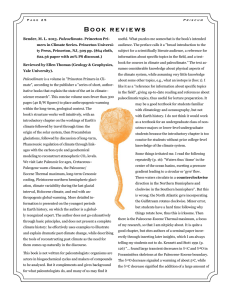Episodes of late Holocene aridity recorded by stalagmites from Devil's
advertisement
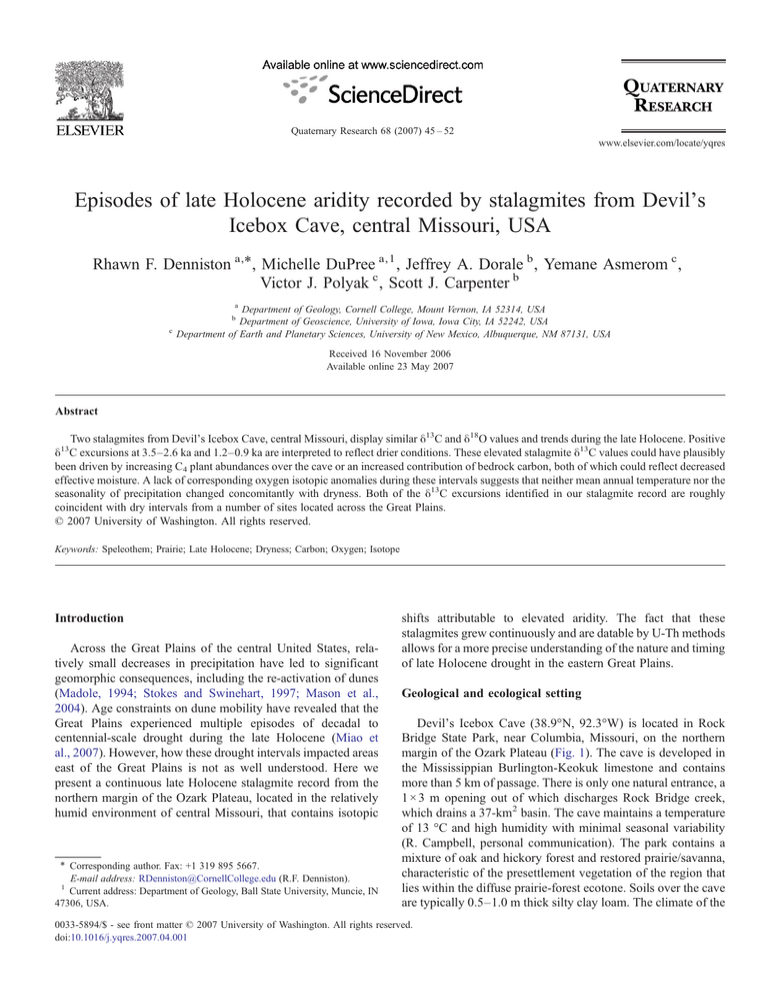
Quaternary Research 68 (2007) 45 – 52 www.elsevier.com/locate/yqres Episodes of late Holocene aridity recorded by stalagmites from Devil's Icebox Cave, central Missouri, USA Rhawn F. Denniston a,⁎, Michelle DuPree a,1 , Jeffrey A. Dorale b , Yemane Asmerom c , Victor J. Polyak c , Scott J. Carpenter b a Department of Geology, Cornell College, Mount Vernon, IA 52314, USA Department of Geoscience, University of Iowa, Iowa City, IA 52242, USA Department of Earth and Planetary Sciences, University of New Mexico, Albuquerque, NM 87131, USA b c Received 16 November 2006 Available online 23 May 2007 Abstract Two stalagmites from Devil's Icebox Cave, central Missouri, display similar δ13C and δ18O values and trends during the late Holocene. Positive δ C excursions at 3.5–2.6 ka and 1.2–0.9 ka are interpreted to reflect drier conditions. These elevated stalagmite δ13C values could have plausibly been driven by increasing C4 plant abundances over the cave or an increased contribution of bedrock carbon, both of which could reflect decreased effective moisture. A lack of corresponding oxygen isotopic anomalies during these intervals suggests that neither mean annual temperature nor the seasonality of precipitation changed concomitantly with dryness. Both of the δ13C excursions identified in our stalagmite record are roughly coincident with dry intervals from a number of sites located across the Great Plains. © 2007 University of Washington. All rights reserved. 13 Keywords: Speleothem; Prairie; Late Holocene; Dryness; Carbon; Oxygen; Isotope Introduction Across the Great Plains of the central United States, relatively small decreases in precipitation have led to significant geomorphic consequences, including the re-activation of dunes (Madole, 1994; Stokes and Swinehart, 1997; Mason et al., 2004). Age constraints on dune mobility have revealed that the Great Plains experienced multiple episodes of decadal to centennial-scale drought during the late Holocene (Miao et al., 2007). However, how these drought intervals impacted areas east of the Great Plains is not as well understood. Here we present a continuous late Holocene stalagmite record from the northern margin of the Ozark Plateau, located in the relatively humid environment of central Missouri, that contains isotopic ⁎ Corresponding author. Fax: +1 319 895 5667. E-mail address: RDenniston@CornellCollege.edu (R.F. Denniston). 1 Current address: Department of Geology, Ball State University, Muncie, IN 47306, USA. shifts attributable to elevated aridity. The fact that these stalagmites grew continuously and are datable by U-Th methods allows for a more precise understanding of the nature and timing of late Holocene drought in the eastern Great Plains. Geological and ecological setting Devil's Icebox Cave (38.9°N, 92.3°W) is located in Rock Bridge State Park, near Columbia, Missouri, on the northern margin of the Ozark Plateau (Fig. 1). The cave is developed in the Mississippian Burlington-Keokuk limestone and contains more than 5 km of passage. There is only one natural entrance, a 1 × 3 m opening out of which discharges Rock Bridge creek, which drains a 37-km2 basin. The cave maintains a temperature of 13 °C and high humidity with minimal seasonal variability (R. Campbell, personal communication). The park contains a mixture of oak and hickory forest and restored prairie/savanna, characteristic of the presettlement vegetation of the region that lies within the diffuse prairie-forest ecotone. Soils over the cave are typically 0.5–1.0 m thick silty clay loam. The climate of the 0033-5894/$ - see front matter © 2007 University of Washington. All rights reserved. doi:10.1016/j.yqres.2007.04.001 46 R.F. Denniston et al. / Quaternary Research 68 (2007) 45–52 Figure 1. Map of the central United States including the locations of sites described in the text (black ovals): Devil's Ice Box cave (DIB); (1) Cold Water Cave; (2) Elk Lake (Bartlein and Whitlock, 1993); (3) Moon Lake (Grimm and Clark, 1998); (4) Little Nemaha River (Baker et al., 2000); (5) Nebraska Sand Hills (Stokes et al., 1999; Swinehart, 1998; Stokes and Swinehart, 1997; Miao et al., 2007); (6) Great Bend Sand Prairie (Arbogast, 1996); (7) Carnegie Canyon (Hall and Lintz, 1984); (8) various dune fields (Clarke and Rendell, 2003; Forman et al., 1995) and the Ozark Plateau (gray oval). Gray lines represent annual average precipitation (cm). area is characterized by warm, humid summers and cool, drier winters (Fig. 2). In this area, dryness increases with distance west from the boundary between the Ozark Plateau and the Great Plains (∼ 95°W longitude) in response to decreasing amounts of precipitation carried by Gulf of Mexico air masses (Fig. 1) and an increase in the dominance of relatively dry Pacific air masses. Methods Figure 2. Monthly averages for the years 1971–2000 for Rock Bridge State Park (http://www.rssweather.com/climate/Missouri/Columbia/). Figure 3. Map of portion of Devil's Ice Box cave including location of Second Breakdown Room and Boxworks Heights where stalagmites were collected. Two broken and down stalagmites, DIB-1 and DIB-2, were obtained from the Second Breakdown Room (Fig. 3), located approximately 30 m below the land surface and 1750 m from R.F. Denniston et al. / Quaternary Research 68 (2007) 45–52 the entrance to Devil's Icebox Cave. The stalagmites were cut in half, polished and inspected. DIB-1 and DIB-2 are 21 and 14 cm tall, respectively, and are composed of dense, clear, finelycrystalline calcite with distinct growth bands and without evidence of any interruptions in growth (Fig. 4). DIB-2 contains minor porosity along its central axis likely related to drip splash. A third late Holocene stalagmite, DIB-3, was collected from Boxwork Heights, a different room located tens of meters from the Second Breakdown Room (Fig. 3) and was ultimately rejected because of high porosity from the central axis to the exterior and isotopic evidence of disequilibrium crystallization (see Results). A total of nine U-Th dates were obtained from DIB-1 and DIB-2 (Table 1) using thermal ionization mass spectrometry at the University of New Mexico Radiogenic Isotope Laboratory. Approximately 150 mg of calcite was milled from the center of the stalagmite using a computer-guided drill and processed using standard chemical separation techniques (Chen et al., 1986). U and Th were measured on a Micromass Sector 54 thermal ionization mass spectrometer with a high-abundance sensitivity filter. All isotopes of interest (236U, 235 U, 234 U, 233U, 232 Th, 230Th, 229Th) were measured on an ion-counting Daly multiplier, requiring very little background correction even for samples with large 232 Th content. Multiplier dark noise was about 0.3 counts per second. An NBL-112A U standard was measured during the course of this study and was in the range of 0.1% of the accepted 234U/238 U ratio. Detrital (unsupported) 230 Th was corrected for using an initial 230Th/232 Th ratio of 4.4 ppm (± 50%). This detrital 230Th correction uncertainty of ± 50% when combined with the relatively low 230 Th/232Th ratios measured in many of the DIB samples is responsible for the relatively large reported age uncertainties—uncertainties Figure 4. Cross-sections of DIB-1 and DIB-2 including dated intervals and corresponding U-Th ages (with 2σ age uncertainties). 47 that are significantly larger than those imparted solely by analytical error. Stalagmites were sampled for stable isotope ratios at 3-mm intervals using a 0.3-mm bur; δ13C and δ18O values of powdered carbonates (0.1 mg) were measured using a Finnigan MAT 252 with a Kiel III automated carbonate device at the University of Iowa's Paul H. Nelson Stable Isotope Laboratory. Daily analysis of NIST and in-house standards produced an analytical precision better than 0.1‰; stable isotope data are reported relative to the PDB standard. Oxygen and U-Th isotopic analyses integrate approximately 5 and 30 yr of growth, respectively. Ages were assigned to individual oxygen isotopic analyses via linear interpolation between consecutive U-Th dates on each stalagmite. Where necessary, radiocarbon dates from the literature were converted to calendar years BP using the Calib 5.0 program (Stuiver and Reimer, 1993). Carbon isotopes in speleothem calcite as indicators of vegetation Dorale et al. (1992) and Baker et al. (1998) linked stalagmite δ13C values to the advance and retreat of prairie grasses in northeastern Iowa. Since then, a great deal of research has been focused on understanding the mechanisms that determine δ13C values and variability in speleothem calcite (for a detailed overview, see review papers by Dorale et al., 2002; Quade, 2004). In general, the four mechanisms capable of producing elevated δ13C values at Devil's Icebox Cave are (1) an increase in the proportion of C4 to C3 plants; (2) a decrease in soil respiration rates leading to an increased contribution of atmospheric CO2 to soil gas; (3) fractionation of carbon isotopes during infiltration and/or the drip step; and (4) an increased limestone carbon component. The δ13C value of soil CO2 reflects the type (C4 vs. C3) of soil organic matter and surficial vegetation. The δ13C values of C3 (e.g., trees and some grasses) and C4 (e.g., many prairie grasses) plants average − 27‰ and − 12‰, respectively (Tieszen and Boutton, 1989). The δ13C value of CO2 respired by vegetation is nearly identical to that of the vegetation itself, and thus changes in vegetation type should result in concomitant shifts in the δ13C values of soil CO2. The isotopic composition of soil CO2 is also impacted by differential molecular diffusion of 13CO2 and 12CO2 at rates proportional to their relative concentrations in the soil atmosphere. For example, at soil CO2 concentrations of 10− 2.0, the δ13C values of CO2 respired by C3 and C4 vegetation (− 27‰ and − 12‰, respectively) is elevated by diffusion by ∼ 4‰ to − 22‰ and − 8‰, respectively (Cerling, 1984), although this may not apply to all cave systems. This diffusion gradient also reflects contributions from atmospheric CO2, and as pre-industrial atmospheric CO2 δ13C values average − 6‰ (Broecker and Peng, 1982), increases in atmospheric CO2 should result in elevated soil CO2 δ13C values. Atmospheric components become negligible outside deserts at depths exceeding ∼ 10 cm (Cerling, 48 R.F. Denniston et al. / Quaternary Research 68 (2007) 45–52 Table 1 Uranium and thorium isotopic ratios and 230Th/234U ages Sample Distance from bottom (mm) 238 U (ng/g) 232 Th (ng/g) δ234U a (measured) 230 Th/234U (activity) 230 Th/232Th (atomic) Uncorrected age (ka) Corrected b, c Age (ka) DIB-01-1 DIB-01-1 DIB-01-1 DIB-01-1 DIB-01-1 DIB-01-2 DIB-01-2 DIB-01-2 DIB-01-2 220 181 85 26 13 140 84 64 7 1260 1380 1830 2450 2550 2510 2200 1120 1900 40.83 27.32 18.80 4.43 27.07 42.74 28.30 39.16 95.61 633 (9) 731 (5) 880 (7) 1056 (6) 1023 (8) 653 (4) 707 (4) 758 (11) 702 (5) 0.0110 (3) 0.0136 (6) 0.0234 (5) 0.0298 (5) 0.0330 (5) 0.0225 (3) 0.0247 (4) 0.0299 (9) 0.0404 (6) 9.0e− 6 (0.1) 1.9e− 5 (0.1) 7.1e− 5 (0.1) 5.6e− 4 (0.1) 1.0e− 4 (0.02) 3.6e− 5 (0.1) 5.4e− 6 (1) 2.6e− 5 (0.1) 2.2e− 5 (0.1) 1.21 (0.03) 1.49 (0.06) 2.59 (0.05) 3.30 (0.07) 3.66 (0.07) 2.48 (0.03) 2.72 (0.03) 3.30 (0.10) 4.49 (0.07) 0.61 (0.30) 1.15 (0.18) 2.42 (0.10) 3.28 (0.07) 3.50 (0.10) 2.01 (0.24) 2.50 (0.12) 2.75 (0.29) 3.61 (0.45) a b c δ234Umeasured = [(234U/238U)measured / (234U/238U)eq − 1] × 103, where (234U/238U)eq is the secular equilibrium atomic ratio: λ238/λ234 = 5.472 × 10− 5. The initial 230Th/232Th ratio of 4.5 × 10− 6 ± 2.25 × 10− 6 was subtracted from measured 230Th/232Th ratios (see text). Values in parentheses represent 2σ errors in the last significant figure. 1984); but in thin soils decreases in soil respiration (root respiration + microbial oxidation of organic material) can lead to an increase in atmospheric CO2 in the soil and thus elevated speleothem δ13C values (Frumkin et al., 2000). Increases in speleothem δ13C values unrelated to vegetation change may occur by rapid infiltration of water through the soil zone that precludes it from reaching isotopic equilibrium with soil CO2 and degassing of drip water in voids above the cave or in the cave itself (Baker et al., 1997). Thus, tests for equilibrium calcite precipitation in a single stalagmite (e.g., the Hendy Test) are insufficient for detecting all modified δ13C signals. The most reliable method for ensuring that speleothem calcite accurately reflects paleovegetation is the documentation of multiple speleothems with similar δ13C values and trends from the same cave (Dorale et al., 1998; Denniston et al., 1999). Temporal variations in the influence of bedrock carbon on speleothem δ13C values may also occur due to changes in infiltration hydrology. Pedogenic carbonates form in soils with an essentially unlimited pool of CO2 and do not derive appreciable carbon from the dissolution of associated carbonate rocks (Quade et al., 1989). Speleothems, on the other hand, form from waters that have passed through the soil into the more closed system of the underlying karst. In this case, approximately half of the carbon in the solution is derived from dissolution of carbonate bedrock (average δ13C = ∼ 0 ± 4‰) (Hendy, 1971). However, the rate of infiltration can impact the nature of this closed system behavior. When the transit time through the bedrock is short (possibly due to conduit flow or a shallow cave), the solution may not reach equilibrium with bedrock carbonate. A slowing of infiltration rate could therefore increase the contribution of bedrock carbon in the infiltrating solution, thereby increasing stalagmite δ13C values. Oxygen isotopes in speleothem calcite as indicators of climate The oxygen isotopic composition of speleothem calcite reflects the δ18O value of infiltrating meteoric waters, crystallization temperature, kinetic effects and/or post-crystallization alteration. As previously discussed, screening for kinetic effects, alteration and even pre-infiltration evaporative enrich- ment of 18O in meteoric waters is accomplished by the existence of identical values and trends in multiple coeval stalagmites. Unless drip water evolves significantly (for example, via multiple steps of calcite crystallization and subsequent dissolution) during its pathway into the cave (Baker et al., 1997), oxygen isotopes of cave drip water should reflect the oxygen isotopic composition of effective infiltration and the temperature at which the calcite precipitates from the dripwater. For middle latitude regions, the global average relationship between the oxygen isotopic composition of mean annual precipitation (MAP) and mean annual temperature (MAT) is +0.6‰/°C (Dansgaard, 1964; Gat, 1980), and the temperature dependence of oxygen isotopic fractionation in the calcite–water system is − 0.23‰/°C. Coupling these two relationships yields a speleothem δ18O vs. mean annual temperature relationship of ∼0.35‰/°C (Dorale et al., 1992). The overall functionality of this relationship has been demonstrated for other speleothems from this region (Dorale et al., 1998), and we apply it here. Results The chronologies of DIB-1 and DIB-2 are derived from linear interpolation between the U-Th mass spectrometry dates obtained from each stalagmite. In both speleothems, growth rates remain largely unchanged from the base to the top of each stalagmite (69 ± 9 μm/yr; n = 4 (1σ) and 86 ± 24 μm/yr; n = 3, for DIB-1 and DIB-2, respectively) (Fig. 5). Although analytical precision was better than 1% for both U and Th isotopic ratios, errors on U-Th ages range from 2% to as high as 50% due to the variable concentration of 232 Th at each dated interval and the quoted uncertainty in the initial 230Th/232 Th ratio. The 232 Th concentration may change significantly from one point in a stalagmite to another and is, in the case of DIB-1 and DIB-2, tied to the amount of detritus, particularly clays, incorporated into the speleothem (Dorale et al., 2004). The measured 230 Th/232 Th ratio is adjusted by subtracting an assumed 230 Th/232Th ratio equal to that of crustal silicates, which has an average value 4.4 ppm, as follows: ! 230 Th 230 230 232 Th corrected ¼ Th measured Th measured 232 Th crustal b ð c R.F. Denniston et al. / Quaternary Research 68 (2007) 45–52 49 though δ13C values begin increasing at 3.6 ka and decline until 2.4 ka. A second, less pronounced positive δ13C anomaly occurs from 1.2 to 0.9 ka with δ13C values beginning to rise at 1.5 ka and falling until 0.8 ka. Discussion Origins of DIB stalagmite δ13C values and variability Figure 5. Carbon (filled circles) and oxygen (open circles) isotopic profiles for DIB-1 and DIB-2 with dated intervals (large circles) and two-sigma age uncertainties (horizontal bars). Gray boxes denote intervals of elevated carbon isotopic values corresponding to high C4/C3 ratios or low infiltration rates at Devil's Icebox. Dark boxes near top denote ice-rafted debris (IRD) minima as presented in Miao et al. (2007) after data in Bond et al. (2001). Since this ratio is not well constrained in DIB stalagmites, however, it is included with an uncertainty of ± 50%. It is unfortunate that the upper date on DIB-1 has an unusually large 232 Th abundance, and thus a large age correction, but the corrected age falls in line with the expected age based on dates from older sections of the same stalagmite, all of which have considerably smaller initial 232Th corrections. Carbon and oxygen isotopic ratios and trends in DIB-1 and DIB-2 are similar (Fig. 5). Oxygen isotopic ratios exhibit little overall variability for DIB-1 (average = − 4.9 ± 0.2‰; n = 66) and DIB-2 (average = − 5.0 ± 0.2‰; n = 53), and both define similar trends of decreasing δ18O values with time (approximately 0.1‰/1 kyr). DIB-3, the stalagmite that was rejected, contains δ18O values similar to those of DIB-1 and DIB-2 but with significantly higher variability (average = − 4.9 ± 0.6‰; n = 64). In addition, δ13C values were extremely noisy, with a ∼ 2‰ offset between numerous adjacent stable isotope samples. The δ13C trends in DIB-1 and DIB-2, however, are considerably less noisy and instead shift smoothly over several hundred years across a range of 2–3‰. The general trend is of a prominent positive δ13C excursion from ∼ 3.5 to 2.6 ka al- According to the model presented above, the periods of elevated δ13C values in DIB speleothems could result from nonequilibrium fractionation of carbon isotopes during infiltration or the drip step (Mickler et al., 2006). However, the likelihood of these effects producing such similar carbon and oxygen trends in multiple stalagmites is unlikely (Denniston et al., 1999). Alternatively, these intervals could reflect an increased contribution of atmospheric carbon, perhaps through a decrease in soil respiration rates. Given the thickness of the soils above DIB, this too seems unlikely. Or, changes in infiltration hydrology may have resulted in a greater bedrock carbon contribution. Finally, increases in C4 biomass could have increased soil gas δ13C values. A study by Hsieh (1993) near Devil's Icebox Cave found soil organic turnover rates on labile fractions to be on the order of decades, supportive of the contention that DIB speleothems should record the timing of vegetation change, if that is indeed the mechanism changing δ13C values, with the minor lag due to soil carbon reservoir effects. Enrichment in 13C of ∼ 10‰ occurs as CO2(g) dissolves in infiltrating meteoric waters and moves through the chemical steps that lead to speleothem calcite (Hendy, 1971). Thus, given a bedrock δ13C value of + 3‰ for the Burlington-Keokuk limestone in central Missouri (Banner and Kaufman, 1994; Cramer et al., in press) and assuming applicability of the Cerling diffusion model to this system, a C3-dominated deciduous forest vegetation with an average δ13 C value of − 27‰ would theoretically produce stalagmite δ13C values of approximately − 4‰ via Eq. (1). ð0:5Þð27x þ 4x þ 10xÞ þ ð0:5Þð3xÞ ¼ 4x ð1Þ Prairie vegetation, with an average C4 value of − 12‰, would theoretically result in stalagmite δ13C values of approximately +2.5‰ (Eq. (2)). ð0:5Þð12x þ 4x þ 10xÞ þ ð0:5Þð3xÞ ¼ 2:5x ð2Þ Thus, the observed shift in stalagmite δ13C values between − 2‰ and − 4‰ are consistent with a C4 plant increase in an overall savanna-type vegetation community, either more forestlike or prairie-like depending on the extent that the Cerling diffusion applies at Devil's Icebox. Origins of DIB stalagmite δ18O trends If interpreted solely in terms of mean annual temperature, the 0.3‰ decrease in stalagmite δ18O values between 3.6 and 0.8 ka represents ∼1 °C of cooling. Such a decrease is not recorded in stalagmites from Cold Water Cave, northeastern 50 R.F. Denniston et al. / Quaternary Research 68 (2007) 45–52 Iowa (Dorale et al., 1992; Denniston et al., 1999); in fact, these stalagmites exhibit a small increase in speleothem δ18O values from 3.0 ka to the present. The origin of this difference in δ18O values between Devil's Icebox and Cold Water Cave is unclear. Several variables such as moisture source impact stalagmite δ18O values (Denniston et al., 1999). The climate of northeastern Iowa is controlled by the interaction of Arctic, Pacific and Gulf of Mexico air masses, while central Missouri is dominated by Gulf of Mexico air. Gulf of Mexico air moisture, which is predominant at both sites, has the highest δ18O values (Simpkins, 1995). Thus, an increase in Gulf of Mexico moisture during the late Holocene at Cold Water Cave could have increased stalagmite δ18O values, but given its position farther north, it would likely have had a similar impact at Devil's Icebox. Alternatively, pre-infiltration evaporative controls on the 18O values of drip water have been suggested during the middle Holocene prairie period (Denniston et al., 1999), but these effects do not appear to have played a role in the late Holocene (post-prairie period) at Cold Water Cave. Changes in precipitation seasonality or mean annual temperature would have plausibly altered the abundance of C4 biomass at DIB because the relation of C4 vegetation to climate in North American prairies is largely a function of maximum summer temperature and the timing and amount of rainfall (Teeri and Stowe, 1976). But no δ18O shift occurs contemporaneously with the periods of elevated δ13C values. Therefore, the monotonic decrease in speleothem δ18O values throughout both DIB-1 and DIB-2, without any departures during the dry intervals at 3.5–2.6 ka and 1.2–0.9 ka, remains unexplained but supports the notion that neither changes in mean annual temperature nor the seasonality of precipitation were responsible for the periods of elevated δ13C values. Comparison with regional records of elevated aridity Varied lines of evidence point to increased aridity across the Great Plains between ∼3.5 and 2.5 ka (Fig. 1). Studies reporting dryness during this interval include Stokes and Swinehart (1997) and Stokes et al. (1999), who interpreted luminescence ages for a parabolic dune in the Sand Hills of Nebraska as indicating discrete dune mobilization events, one of which was 3.5–2.8 ka. Other study areas showing late Holocene dune mobility include south-central Kansas (Arbogast, 1996). By analyzing prairie macrofossils and δ13C values of soil organic matter, Baker et al. (2000) noted a strong C4 plant pulse from 3520 to 3030 cal yr BP in southeastern Nebraska. Similarly, Grimm and Clark (1998) identified an increase in Ambrosia pollen from 3800 to 2800 cal yr BP from lakes in the Sand Hills of Nebraska and eastern North Dakota. Analyses of buried soils, buried trees and mollusks from west-central Oklahoma suggest drier-than-present conditions from approximately 3400 to 2800 cal yr BP (Hall and Lintz, 1984). Miao et al. (2007) report an extensive and well-dated (via OSL and 14C) stratigraphic record of dune fields and loess deposits from the Great Plains that preserves evidence of dune and loess mobilization at 4.5–2.3 ka with peaks centered around 3.8 and 2.5 ka and again from 1.0 to 0.7 ka. This latter dry interval at approximately 1.0 ka has also been reported by several authors (Forman et al., 1995; Stokes and Swinehart, 1997; Swinehart, 1998; Stokes et al., 1999; Swinehart et al., 2000; Cook et al., 2004; Mason et al., 2004; Daniels and Knox, 2005), but a clear picture of regional drought is not always evident. For example, multi-proxy evidence from varved lake sediments at Elk Lake, Minnesota, and other areas suggest a warm and moist late Holocene (3.5 ka to present) uninterrupted by significant drought (Bartlein and Whitlock, 1993; Fritz et al., 2001). The OSL- and radiocarbon-dated record of Miao et al. (2007) offers perhaps the most robust chronology for any late Holocene sequence of aridity changes and thus offers a solid basis for comparison with the Devil's Icebox speleothem record. Within the time frame marked by DIB speleothems, loess mobilization in the Sand Hills clustered at 0.67 ± 0.1 ka, 2.5 ± 0.1 ka and 3.8 ± 0.3 ka (2σ). In contrast, the DIB record suggests a more sustained dry interval between 3.5 and 2.5 ka in central Missouri. Similarly, increases in aridity may have occurred earlier at Devil's Icebox between 1.3 and 0.8 ka (Fig. 5). However, dates on eolian sand contain more scatter than dates on loess, with eolian sand ages ranging back to approximately 1.1 ka, more in agreement with the onset of aridity at Devil's Icebox. Mid-continent aridity has been linked to cool eastern tropical Pacific sea surface temperatures and a warm north Atlantic (Schubert et al., 2004). Miao et al. (2007) tied increased aridity in central Nebraska at 3.8, 2.5 and 0.7 ka to periods of reduced ice-rafted debris (IRD), but noted that dating errors coupled with lags in the eolian response system make their correlation tenuous. The DIB speleothem record supports a correlation between an IRD minimum and elevated speleothem δ13C values from ∼ 1.2 to 0.8 ka but does not support this correlation from ∼2.6 to 2.0 ka (Fig. 5). In fact, the latter period falls nicely between IRD minima. Miao et al. (2007) also investigated the link between ENSO and mid-continent aridity but their interpolation is partly limited by uncertainties in their chronology. The fact that episodes of aridity documented from the Great Plains appear to extend eastward into the more humid areas of the Ozark Plateau suggest that longer, high-resolution speleothem records spread across the Eastern Plains may offer unique insight into the timing and causes of regional aridity. Conclusions Two intervals of elevated stalagmite δ13C values occur at 3.4–2.6 and 1.2–1.0 ka at Devil's Icebox Cave. The exact mechanism driving these changes in stalagmite δ13C values is unclear, but it appears likely associated with increased aridity, either through increases in C4 abundance or the proportion of bedrock carbon in infiltrating solutions. The limited impact of temperature change during these elevated δ13C episodes is supported by the absence of concomitant increases in stalagmite δ18O values. The observation that the timing of these more arid periods at Devil's Icebox Cave are similar but not identical to the timing of more arid intervals across the eastern Great Plains may be explained by (1) different response rates to climate change among caves, dunes and pollen/macrofossil records; (2) errors and uncertainties among the distinct chronologies (U- R.F. Denniston et al. / Quaternary Research 68 (2007) 45–52 series for stalagmites vs. OSL or 14C dunes vs. 14C for pollen/ macrofossils); and/or (3) temporal and/or geographic heterogeneity during periods of enhanced aridity. Across the Eastern Plains, karst is abundant and the high temporal resolution inherent to the speleothem record points to its utility in reconstructing episodes of heightened aridity. Acknowledgments Samples were collected with the permission of the Missouri State Department of Natural Resources under the guidance of Roxie Campbell and Scott Schulte at Rock Bridge Memorial State Park and with the assistance of Mark Ellefsen. This research was funded by grants from the Iowa Science Foundation/Iowa Academy of Science and Cornell College. This manuscript benefited from critical reviews by Jay Quade, Brandon Curry, Samuel Panno and an anonymous reviewer. References Arbogast, A.F., 1996. Stratigraphic evidence for late-Holocene Aeolian sand mobilization and soil formation in south-central Kansas, U.S. Journal of Arid Environments 34, 403–411. Baker, A., Ito, E., Smart, P.L., McEwan, R.F., 1997. Elevated and variable values of 13C in speleothems in a British cave system. Chemical Geology 136, 263–270. Baker, R.G., González, L.A., Raymo, M., Bettis III, E.A., Reagan, M.K., Dorale, J.A., 1998. Comparison of multiple proxy records of Holocene environments in the midwestern United States. Geology 26, 1131–1134. Baker, R.G., Fredlund, G.G., Mandel, R.D., Bettis III, E.A., 2000. Holocene environments of the central Great Plains: multi-proxy evidence from alluvial sequences, southeastern Nebraska. Quaternary International 67, 75–88. Banner, J.L., Kaufman, J., 1994. The isotopic record of ocean chemistry and diagenesis preserved in non-luminescent brachiopods from Mississippian carbonate rocks, Illinois and Missouri. Geological Society of America Bulletin 106, 1074–1082. Bartlein, P.J., Whitlock, C., 1993. Paleoclimatic interpretation of the Elk Lake record. In: Bradbury, J.P., Dean, W.E. (Eds.), Elk Lake, Minnesota; Evidence for Rapid Climate Change in the North-Central United States. Geological Society of America, Boulder, CO, pp. 275–293. Bond, G., Kromer, B., Beer, J., Muscheler, R., Evans, M.N., Showers, W., Hoffman, S., Lotti-Bond, R., Hajdas, I., Bonani, G., 2001. Persistent solar influence on North Atlantic climate during the Holocene. Science 294, 2130–2136. Broecker, W.S., Peng, T.H., 1982. Tracers in the Sea. Eldigio Press, Palisades, New York. 690 pp. Cerling, T.E., 1984. The stable isotopic composition of modern soil carbonate and its relationship to climate. Earth and Planetary Science Letters 71, 229–240. Chen, J., Edwards, L., Wasserburg, W., 1986. 238U, 234U, and 232Th in seawater. Earth and Planetary Science Letters 80, 241–251. Clarke, M.L., Rendell, H.M., 2003. Late Holocene dune accretion and episodes of persistent drought in the Great Plains of Northeastern Colorado. Quaternary Science Reviews 22, 1051–1058. Cook, E.R., Woodhouse, C.A., Eakin, C.M., Meko, D.M., Stahle, D.W, 2004. Long-term aridity changes in the western United States. Science 306, 1015–1018. Cramer, B.S., Saltzman, M.R., Day, J.E., Witzke, B.J., in press. Lithological expression of global positive carbon isotope excursions in Epeiric sea settings: carbonate production, organic carbon burial, and oceanography during the late Famennian, Special Paper-Geological Association of Canada. Daniels, J.M., Knox, J.C., 2005. Alluvial stratigraphic evidence for channel incision during the Medieval Warm Period, Central Great Plains, USA. Holocene 15, 736–747. 51 Dansgaard, W., 1964. Stable isotopes in precipitation. Tellus 16, 436–468. Denniston, R.F., González, L.A., Asmerom, Y., Baker, R.G., Reagan, M.K., Bettis III, E.A., 1999. Evidence for increased cool season moisture during the middle Holocene. Geology 27, 815–818. Dorale, J.A., González, L.A., Reagan, M.K., Pickett, D.A., Murrell, M.T., Baker, R.G., 1992. A high-resolution record of Holocene climate change in speleothem calcite from Cold Water Cave, northeast Iowa. Science 258, 1626–1630. Dorale, J.A., Edwards, R.L., Ito, E., Gonzalez, L.A., 1998. Climate and vegetation history of the mid-continent from 75 to 25 ka: a speleothem record from Crevice Cave, Missouri, USA. Science 282, 1871–1874. Dorale, J.A., Edwards, R.L., Onac, B.P., 2002. Stable isotopes as environmental indicators in speleothems. In: Yuan, D.-X. (Ed.), Karst Processes and the Carbon Cycle. Geological Publishing House, Beijing, pp. 107–120. Dorale, J.A., Edwards, R.L., Alexander Jr., C.A, Shen, C.-C., Richards, D.A., Cheng, H., 2004. Uranium-series dating of speleothems: current techniques, limits and applications. In: Sasowsky, I.D., Mylroie, J.E. (Eds.), Studies of Cave Sediments: Physical and Chemical Records of Paleoclimate. Kluwer Academic/Plenum Publishers, NY, pp. 177–197. Forman, S.L., Oglesby, R., Markgraf, V., Stafford, T., 1995. Paleoclimatic significance of Late Quaternary Eolian deposition on the Piedmont and High Plains, Central United States. Global and Planetary Change 11, 35–55. Fritz, S.C., Metcalfe, S.E., Dean, W., 2001. Holocene climate patterns in the Americas from paleolimnological records. In: Markgraf, V. (Ed.), Interhemispheric Climate Linkages. Academic Press, San Diego, CA, pp. 163–241. Frumkin, A., Ford, D.C., Schwarcz, H.P., 2000. Paleoclimate and vegetation of the last glacial cycles in Jerusalem from a speleothem record. Global Biogeochemical Cycles 14, 863–870. Gat, J.R., 1980. The isotopes of hydrogen and oxygen in precipitation. In: Fritz, P., Fontes, J. (Eds.), Handbook of Environmental Isotope Geochemistry. Elsevier, New York, pp. 21–44. Grimm, E.C., Clark, J.S., 1998. Holocene vegetation and climate change in the northern Great Plains: evidence from pollen and charcoal studies. Geological Society of America Annual Meeting Abstracts with Programs, v., p. Hall, S.A., Lintz, C., 1984. Buried trees, water table fluctuations, and 3000 years of changing climate in west-central Oklahoma. Quaternary Research 22, 129–133. Hendy, C.H., 1971. The isotopic geochemistry of speleothems—I. The calculation of the effects of different modes of formation on the isotopic composition of speleothems and their applicability as palaeoclimatic indicators. Geochimica et Cosmochimica Acta 35, 801–824. Hsieh, Y.-P., 1993. Radiocarbon signatures of turnover rates in active soil organic carbon pools. Soil Science Society of America Journal 57, 1020–1022. Madole, R.F., 1994. Stratigraphic evidence of desertification in the west-central Great Plains within the past 1000 yr. Geology 22, 483–486. Mason, J.A., Swinhart, J.B., Goble, R.J., Loope, D.B., 2004. Late Holocene dune activity linked to hydrological drought, Nebraska Sand Hills, USA. Holocene 14, 209–217. Miao, X., Mason, J., Swinehart, J.B., Loope, D.B., Hanson, P.R., Goble, R.J., Liu, X., 2007. A 10,000 year record of dune activity, dust storms, and severe drought in the central Great Plains. Geology 35, 119–122. Mickler, P.J., Stern, L.A., Banner, J.L., 2006. Large kinetic isotope effects in modern speleothems. Geological Society of America Bulletin 118, 65–81. Quade, J., 2004. Isotopic records from ground-water and cave speleothem calcite in North America. In: Gillespie, A.R., Porter, S.C., Atwater, B.F. (Eds.), The Quaternary Period in the United States. Developments in Quaternary Science, vol. 1. Elsevier, pp. 205–220. Quade, J., Cerling, T.E., Bowman, J.R., 1989. Systematic variation in the carbon and oxyge isotopic composition of Holocene soil carbonate along elevation transects in the southern Great Basin, USA. Geological Society of America 101, 464–475. Schubert, S.D., Suzrez, M.J., Pegion, P.J., Koster, R.D., Bacmeister, J.T., 2004. On the cause of the 1930s Dust Bowl. Science 303, 1855–1859. Simpkins, W.W., 1995. Isotopic composition of precipitation in central Iowa. Journal of Hydrology 172, 185–207. Stokes, S., Swinehart, J.B., 1997. Middle- and late-Holocene dune reactivation in the Nebraska Sand Hills, USA. Holocene 7, 263–272. Stokes, S., Rich, J., Swinehart, J., Loope, D.B., 1999. Holocene timing of 52 R.F. Denniston et al. / Quaternary Research 68 (2007) 45–52 megabarchan dune construction in the Nebraska Sand Hills. Geological Society of America Fall Meeting Abstracts with Program 31, 231. Stuiver, M., Reimer, P.J., 1993. Extended 14C database and revised CALIB radiocarbon calibration program. Radiocarbon 35, 215–230. Swinehart, J.B., 1998. Holocene climate variability in the central Great Plains; the record from Eolian and lake/marsh sediments. Geological Society of America Fall Meeting Abstracts with Program 30, 250. Swinehart, J., Nicholson, B., Loope, D., Nicklen, B., 2000. Latest Wisconsin and Holocene climatic fluctuations in a Nebraska Sand Hills peatland inferred from suspended sand content and plant macrofossils. Geological Society of America Fall Meeting Abstracts with Program 32, 95. Teeri, J.A., Stowe, L.G., 1976. Climatic patterns and the distribution of C4 grasses in North America. Oecologia 23, 1–12. Tieszen, L.L., Boutton, T., 1989. In: Rundel, P.W., Ehlerlinger, J.R., Nagy, K.A. (Eds.), Stable Isotopes in Ecological Research. Springer-Verlag, New York, pp. 167–195.
